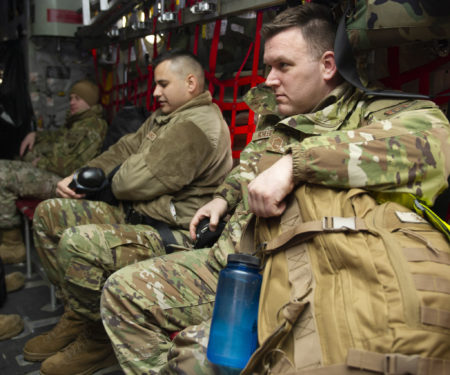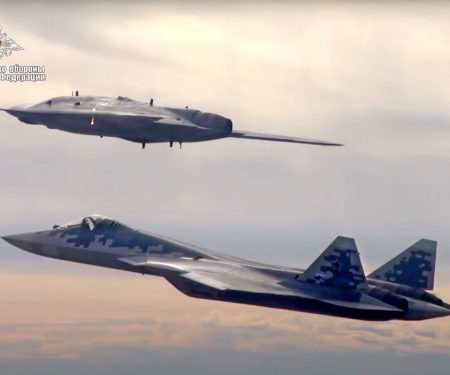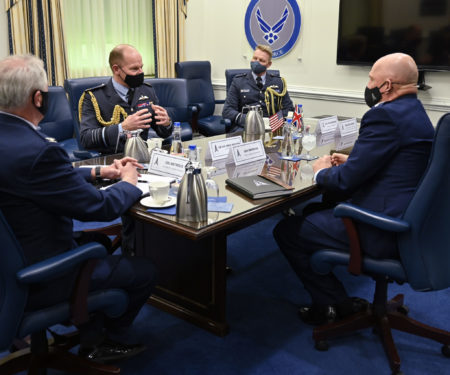Radar Sweep
A Prototype Spy Plane is Tracking Russian Force Movements for the US Army
As the world waits on Russia’s next move in its slow-rolling invasion of Ukraine, U.S. military aircraft continue flights over Eastern Europe, searching for changes in Russia’s posture along Ukraine’s border that could give clues about its next moves. Flying in the region among the U.S. military’s submarine hunting planes and surveillance drones is a novel intelligence-gathering aircraft prototype known as ARTEMIS—a Bombardier Challenger 650 that’s been souped up with military-grade sensors for tracking ground troops, flown on behalf of the US Army by defense contractor Leidos.
Ukraine Prepares to Remove Data from Russia’s Reach
Ukraine’s government is preparing to wipe its computer servers and transfer its sensitive data out of Kyiv if Russian troops move to seize the capital, a senior Ukrainian cyber official said. The worst-case contingency planning addresses an unintended consequence of a security measure the government took in 2014, when it began centralizing its computer systems after Russia and pro-Moscow separatists seized control of Crimea and the Donbas region. That measure made it harder for Russian hackers to penetrate computers that store critical data and provide services such as pension benefits, or to use formerly government-run networks in the occupied territories to launch cyberattacks on Kyiv. But it’s also created a tempting target in the capital for Russia’s military, which has begun moving into separatist-controlled territories of eastern Ukraine.
B-52s Complete Bomber Task Force Mission With Czech Fighter Jets
Air Force B-52 Stratofortress jets participated in a NATO Allied Air Command bomber task force mission alongside fighter aircraft from the Czech Republic, conducting bilateral and theater familiarization operations. The B-52s landed in the Czech Republic on Feb. 21, practicing quick-turn sortie generation, a maneuver in which pilots and air crew shut off aircraft engines, repack parachutes, and refuel for quick-mission turn around capabilities.
National Guard Troops Requested to Help During Possible Trucker Protests
The Capitol Police and the D.C. Homeland Security and Emergency Management Agency have asked the Defense Department for National Guard troops to help local agencies during trucker convoys that threaten to disrupt traffic in the Washington, D.C., region in the coming days.
Emergency Funding Proposal for Ukraine Gets Bipartisan Backing in Congress
New funding legislation to address the Ukraine crisis is in the works, with potential action next week, U.S. lawmakers said Feb. 22. Congressional Republicans and Democrats are signaling support for supplemental spending amid Russian troop deployments in eastern Ukraine. Some lawmakers are also pushing to boost weapons deliveries from the U.S. to Ukraine—support that is already underway. “I’ve been on the phone with Democratic senators for the last two days. We’re talking about an emergency supplemental to be created next week,” South Carolina Republican Sen. Lindsey Graham, a senior appropriator, told reporters.
Space Force Has Ambitious Goals for Year Three of Operations
With more than two years under its belt, the U.S. military’s newest service is gearing up for expanded operations and new milestones in 2022. Officials at the Space Force have been working to flesh out the organization as it releases new doctrines and brings on new Guardians. The amount of progress the service has made so far is significant, said Chief of Space Operations Gen. John “Jay” Raymond, who took the helm in December 2019.
Biden Signs Stopgap Funding Bill With $350 Million for Military’s Water Contamination Response in Hawaii
President Joe Biden signed into law a stopgap funding bill to avert a federal shutdown that also provides the Pentagon some $350 million to bolster its response to a contaminated drinking water emergency at a military installation in Hawaii. Biden’s signature ensured the government will remain funded through March 11, just hours before the last temporary spending measure that he signed into law Dec. 2 was set to expire. The new law provides funding largely at fiscal year 2021 spending levels, but lawmakers also included the new money to address the contamination crisis at the Navy’s Red Hill Bulk Fuel Storage Facility at Joint Base Pearl Harbor-Hickam. Officials in November discovered a petroleum leak from the World War II-era fuel storage facility into the drinking water supply for some on-post housing after residents complained their water smelled foul. Some 6,000 people have been treated for health issues since the spill.
Missile Warning & Defense
Defending against missile threats launched in, at, or through space has never been more challenging—or important. Learn more on Air Force Magazine’s Missile Warning & Defense page.
European Union Cyber Defense Team Deploys to Aid Ukraine
Several European Union member states are activating a team of specialists to help Ukraine ward off Russian cyberattacks, which have previously accompanied kinetic combat ordered by Moscow. The Defence Ministry of Lithuania—the lead nation for the Cyber Rapid Response Team project—announced the move, saying the Ukrainian government requested the aid. Croatia, Estonia, the Netherlands, Poland, and Romania also are part of the project, sponsored by the EU’s Permanent Structured Cooperation defense and security initiative.
PODCAST: Russia, China, and the US Air Force Stretched Too Thin
In episode 64 of the Aerospace Advantage podcast, “Russia, China, and the U.S. Air Force Stretched Too Thin: We’ve Been Here Before—Lessons from Korea,” host John “Slick” Baum engages with the Mitchell Institute’s executive director Doug Birkey to discuss his latest report regarding the air war over Korea and why the lessons from that conflict matter more than ever today. Often lost between World War II and Vietnam, the air war over Korea holds particular relevance for members of today’s Air Force as they seek to address a strikingly similar set of challenges—everything from a small, old aircraft inventory to factors such as air base availability and defense, logistics under attack, lack of training capacity, and disagreement with joint counterparts about how best to employ airpower.
OPINION: Italy Is a Quiet Pillar of NATO’s Aerial Policing
“The world has heard a great deal about the various weapons NATO member states are sending to Ukraine—and about the 5,000 helmets the Germans are sending. But it’s heard less, if anything, about Italy’s current policing of the skies above the Black Sea, its recent air policing in the Baltic skies, or for that matter its aircraft-carrier-based patrolling of the Mediterranean. Indeed, Italy has established itself as a stalwart of NATO’s various air policing programs. But because Rome rarely makes a fuss about the rotations, its hefty contribution flies largely under the radar,” writes Elisabeth Braw, senior fellow at the American Enterprise Institute.
Shield AI to Work on Swarming Drones, Autonomous Rotorcraft for Air Force
A small San Diego-based startup is developing artificial intelligence software that could put the Air Force one step closer to fielding swarming drones and autonomous electric rotorcraft. Shield AI announced that it received an Air Force contract worth up to $60 million for a series of projects involving the company’s Hivemind autonomy stack, a common AI system the company is developing to control everything from small drones to—potentially one day in the future—fighter jets such as the F-16.
US and International Partners to Share Launch Cost of New Communications Satellite
U.S. officials are in talks with international users of the Wideband Global Satcom communications satellites about a cost-sharing agreement to fund the launch of the new WGS-11+. “The Department of the Air Force and the U.S. Space Force conducted exploratory discussions with current WGS partners and two new partners to meet the costs associated with launch and ground integration of WGS 11+ throughout its acquisition strategy development,” Keith Anderson, business and financial manager for military satcom international partners, said Feb. 22 in a statement.
PHOTOS: See the Military Aircraft That Took Part in the Singapore Airshow
Aircraft from militaries across the globe were on display at the Singapore Airshow that lasted from Feb. 14 to 18. Check out images of the different fighters, tankers, and more.




